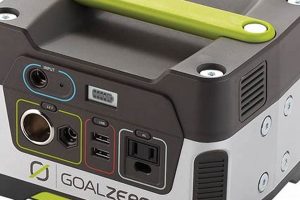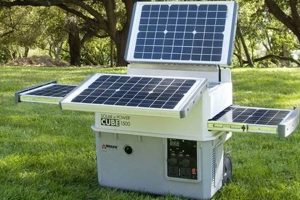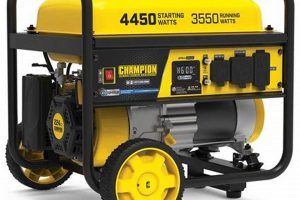Small, mobile power sources offer a practical solution for temporary electricity needs. These units can supply power to essential appliances and devices during outages caused by weather events or grid failures. For instance, a refrigerator, a few lights, and a sump pump could be run simultaneously using a properly sized portable generator.
The ability to maintain critical functions during power disruptions provides significant peace of mind and can prevent costly disruptions. Historically, relying solely on utility companies meant vulnerability to extended blackouts. Portable generators offer a level of energy independence, ensuring essential services remain operational and safeguarding against potential losses. This is particularly crucial for individuals reliant on medical equipment or those living in areas prone to power outages.
Understanding the capabilities and limitations of these devices is crucial for effective emergency preparedness. Topics such as generator sizing, proper usage procedures, safety precautions, and maintenance requirements will be explored in detail.
Tips for Utilizing Portable Generators
Effective use of a portable generator requires careful planning and adherence to safety guidelines. The following tips offer valuable insights for maximizing benefits and ensuring safe operation.
Tip 1: Accurate Power Needs Assessment: Calculate the wattage requirements of appliances intended for generator power. Consider starting wattage, which is typically higher than running wattage.
Tip 2: Proper Generator Sizing: Select a generator with sufficient wattage capacity to handle the combined load of essential appliances. Overloading a generator can lead to damage and safety hazards.
Tip 3: Safe Connection Procedures: Never connect a portable generator directly to household wiring. Use a transfer switch installed by a qualified electrician to safely isolate the generator’s power from the utility grid.
Tip 4: Adequate Ventilation: Operate generators outdoors in well-ventilated areas to prevent carbon monoxide poisoning. Maintain a safe distance from windows, doors, and vents.
Tip 5: Routine Maintenance: Regularly inspect and maintain the generator according to manufacturer recommendations. This includes oil changes, air filter cleaning, and spark plug replacement.
Tip 6: Fuel Storage Safety: Store fuel in approved containers in a well-ventilated area away from ignition sources. Never refuel a hot generator.
Tip 7: Grounding the Generator: Properly ground the generator to prevent electrical shock. Consult the owner’s manual for grounding instructions.
Tip 8: Dry Operation Prevention: Ensure the generator has sufficient oil levels before and during operation. Running a generator without oil can cause severe engine damage.
Adhering to these guidelines ensures efficient operation and mitigates potential hazards. Careful planning and responsible usage will maximize the benefits of portable power generation.
By understanding these essential aspects, individuals can harness the full potential of portable generators safely and effectively.
1. Generator Size
Generator size is a critical factor in determining whether a portable unit can effectively power a house. Selecting an appropriately sized generator ensures sufficient power for essential appliances during outages. Undersized generators may overload and fail, while oversized generators represent unnecessary expense and fuel consumption. Understanding the relationship between generator size and power requirements is crucial for successful power management.
- Running Watts vs. Starting Watts
Appliances have two wattage ratings: running watts and starting watts. Running watts represent the power needed for continuous operation, while starting watts reflect the surge required for initial motor startup. Starting watts are typically two to three times higher than running watts. Accurately calculating both values for intended appliances is essential for proper generator sizing. For example, a refrigerator might require 700 running watts but 2100 starting watts. Ignoring starting wattage can lead to generator overload and appliance malfunction.
- Calculating Total Power Requirements
Determine the combined running watts of all appliances planned for simultaneous generator operation. Add a buffer for unexpected loads. This total wattage represents the minimum running wattage capacity required from the generator. For example, if the combined running wattage of essential appliances is 3000 watts, a generator with a minimum capacity of 3500 running watts offers a safety margin. This prevents overloading and ensures reliable power delivery.
- Whole-House vs. Essential Appliances
Generator sizing strategies differ based on desired coverage. Powering a whole house during an outage requires a significantly larger generator than powering only essential appliances. Consider prioritizing critical circuits, such as refrigerators, lighting, and heating systems, for efficient resource allocation. For example, a 10,000-watt generator might be necessary for whole-house power, whereas a 5,000-watt unit can effectively power essential circuits. Prioritization optimizes generator usage and minimizes fuel consumption.
- Generator Wattage Capacity Options
Portable generators are available in a wide range of wattage capacities, typically from 2,000 watts to 10,000 watts or more. Matching generator capacity to calculated power needs ensures efficient operation. Smaller generators are suitable for limited appliance usage, while larger generators offer broader coverage. Consider future power needs when selecting a generator. For instance, opting for a slightly larger generator than current needs accommodates potential future appliance additions.
Careful consideration of generator size is paramount for successful power management during outages. By accurately assessing power needs, understanding wattage requirements, and selecting an appropriately sized generator, homeowners can effectively utilize portable generators to maintain essential functions and enhance resilience during power disruptions.
2. Power Requirements
Power requirements are fundamental to determining whether a portable generator can effectively power a house. The total electrical load of the house, expressed in watts, dictates the minimum generator capacity necessary. This load encompasses all appliances and devices intended for simultaneous operation during a power outage. Accurately assessing power requirements is crucial for appropriate generator selection and successful power management. For example, a household prioritizing essential appliances like a refrigerator, sump pump, and a few lights might have a significantly lower power requirement than a household intending to maintain full functionality, including air conditioning and multiple electronic devices.
The relationship between power requirements and generator capacity is a crucial factor in determining the feasibility of using a portable generator. An undersized generator, unable to meet the power demands, risks overload and potential damage, while an oversized generator incurs unnecessary expense and fuel consumption. Careful calculation of anticipated loads, including both running and starting wattage of appliances, ensures efficient and effective utilization. Consider a scenario where a homeowner underestimates the starting wattage of a well pump; attempting to start the pump with an undersized generator could overload the unit, potentially causing damage to both the generator and the pump. Conversely, a homeowner overestimating their needs and purchasing a significantly larger generator than necessary incurs higher purchase costs and consumes more fuel than required.
Understanding household power requirements is essential for effective emergency preparedness. This knowledge guides informed decisions about generator selection, load management, and fuel budgeting. By accurately assessing power needs and matching them to an appropriately sized generator, homeowners can ensure reliable backup power during outages, minimizing disruption and maximizing the effectiveness of their portable power solution. Failing to accurately calculate power requirements can lead to insufficient power supply, appliance malfunction, or even generator damage. Therefore, careful planning and accurate assessment are critical components of successful portable generator utilization.
3. Transfer Switch
Transfer switches play a critical role in safely connecting a portable generator to a house. They prevent dangerous backfeeding, which can harm utility workers and damage appliances. Understanding their function and importance is essential for anyone considering generator usage.
- Preventing Backfeeding
Backfeeding occurs when electricity flows from the generator back into the utility grid. This poses a serious electrocution risk to utility line workers and can damage grid equipment. A transfer switch isolates the house from the grid during generator operation, eliminating this hazard. Without a transfer switch, the generator’s electricity could energize seemingly dead power lines, posing a significant safety threat.
- Types of Transfer Switches
Two primary types of transfer switches exist: manual and automatic. Manual switches require the homeowner to physically move a lever or switch to change the power source. Automatic transfer switches detect a power outage and automatically switch to the generator, offering greater convenience and faster response times, particularly beneficial for unattended operation or individuals less familiar with manual switching procedures.
- Professional Installation
Transfer switch installation should always be performed by a qualified electrician. Incorrect installation can compromise safety and potentially damage the electrical system. Professional installation ensures adherence to electrical codes and proper grounding, reducing risks and ensuring system integrity. Attempting DIY installation could result in hazardous wiring errors and void insurance coverage.
- Legal Requirements and Safety Standards
Many jurisdictions require transfer switches for generator connection. These regulations reflect the inherent safety risks associated with backfeeding. Adherence to local electrical codes and safety standards is paramount. Failure to comply can result in fines and jeopardize safety. Consulting a licensed electrician ensures compliance with local regulations and best practices.
A transfer switch is not merely a convenient accessory but a critical safety component for generator usage. Its proper installation and operation are essential for protecting both individuals and the electrical grid. Choosing the right type and ensuring professional installation contribute significantly to the safe and effective use of a portable generator to power a house during outages.
4. Safety Procedures
Safe operation is paramount when utilizing a portable generator to power a house. Overlooking safety procedures can lead to severe consequences, including carbon monoxide poisoning, fire hazards, and electrical shock. The connection between safety procedures and the feasibility of powering a house with a portable generator is inextricably linked; neglecting these procedures renders the entire endeavor inherently unsafe and potentially disastrous. For example, operating a generator indoors or in a poorly ventilated area can lead to a rapid buildup of carbon monoxide, an odorless, colorless gas that can cause severe illness or death. Similarly, improper fuel handling, such as refueling a hot generator, can result in fires or explosions.
Several key safety procedures must be followed. Generators should always be operated outdoors in a well-ventilated area, far from windows, doors, and vents. Proper grounding is crucial to prevent electrical shock. Fuel should be stored in approved containers away from ignition sources. Never refuel a hot generator, and allow it to cool completely before adding fuel. Regular maintenance, including oil changes and air filter cleaning, ensures optimal performance and reduces the risk of malfunctions that could pose safety hazards. For instance, neglecting regular maintenance can lead to increased carbon monoxide emissions or even engine fires. Using extension cords specifically designed for outdoor use and rated for the appropriate wattage is crucial; overloading an extension cord can cause overheating and fire hazards.
Understanding and implementing these safety procedures is not merely a recommendation but a critical requirement for responsible generator use. Ignoring these guidelines significantly increases the risk of accidents and negates the benefits of having a backup power source. Adherence to safety protocols transforms a potentially hazardous situation into a manageable and effective solution for temporary power needs. Safe operation ensures the well-being of individuals and preserves the integrity of the electrical system. Ultimately, a comprehensive understanding of and adherence to safety procedures directly impacts the viability and safety of using a portable generator to power a house.
5. Fuel Capacity
Fuel capacity directly impacts the duration a portable generator can power a house. The size of the fuel tank determines the generator’s runtime, influencing the practicality and effectiveness of its use during extended power outages. Understanding the relationship between fuel capacity and power needs is crucial for effective planning and preparedness.
- Runtime and Power Output
The generator’s runtime, determined by fuel capacity and power output, dictates how long it can sustain electrical loads. Higher power output consumes fuel more rapidly, reducing runtime. For instance, a generator with a small fuel tank operating at near-maximum capacity will deplete its fuel supply much faster than a larger tanked generator running a lighter load. Selecting a generator with appropriate fuel capacity is essential to meet desired runtime requirements during an outage.
- Fuel Type and Efficiency
Different fuel typesgasoline, propane, or dieselinfluence runtime and require specific storage considerations. Propane offers longer shelf life, while gasoline requires more frequent replenishment. Fuel efficiency varies between generator models and impacts fuel consumption rates. Choosing a fuel-efficient model can extend runtime and reduce operational costs, especially during extended outages. For example, a diesel generator typically consumes less fuel per kilowatt-hour than a comparable gasoline model, resulting in longer runtimes for the same fuel capacity.
- Fuel Storage and Availability
Safe and adequate fuel storage is essential. Properly sealed containers in well-ventilated areas minimize risks and preserve fuel quality. Fuel availability during emergencies can be uncertain; having an adequate supply on hand ensures uninterrupted power when needed. Pre-planning fuel storage and procurement is crucial for sustained generator operation during prolonged outages. For example, storing sufficient fuel in approved containers prior to hurricane season ensures readiness for potential power disruptions.
- Refueling Frequency and Logistics
Frequent refueling disrupts generator operation and requires careful planning. Generators must be shut down and cooled before refueling, creating temporary power interruptions. Accessibility to fuel sources during emergencies can be challenging; pre-identifying fuel suppliers and having backup plans are essential for uninterrupted operation. Calculating estimated fuel consumption and establishing a refueling schedule minimizes disruptions during extended power outages.
Fuel capacity is a crucial factor in determining the practicality and effectiveness of using a portable generator to power a house. By carefully considering runtime requirements, fuel type, storage logistics, and refueling frequency, homeowners can effectively plan for sustained power generation during outages, maximizing the benefits and minimizing potential disruptions. An informed understanding of fuel capacity and its implications ensures a reliable and sustainable backup power solution.
Frequently Asked Questions
This section addresses common inquiries regarding the use of portable generators for residential power supply.
Question 1: What size generator is needed to power a typical house?
Generator sizing depends on the specific power requirements of the household. Calculating the total wattage of essential appliances is crucial for determining the appropriate generator size. A qualified electrician can assist with this assessment.
Question 2: Is it safe to connect a portable generator directly to household wiring?
Direct connection is extremely dangerous and should never be attempted. A properly installed transfer switch is required to isolate the generator’s power from the utility grid, preventing backfeeding and ensuring safety.
Question 3: Can a portable generator power an entire house, including air conditioning?
While possible, powering an entire house, especially with energy-intensive appliances like air conditioners, requires a significantly larger and more powerful generator. Prioritizing essential circuits is often more practical and fuel-efficient.
Question 4: What type of fuel is best for a portable generator?
Several fuel types are available, including gasoline, propane, and diesel. Each has advantages and disadvantages regarding storage, availability, and cost. Selection depends on individual circumstances and preferences.
Question 5: Where should a portable generator be operated?
Generators must be operated outdoors in well-ventilated areas away from windows, doors, and vents to prevent carbon monoxide poisoning. Maintaining a safe distance from flammable materials is also crucial.
Question 6: How often should a portable generator be maintained?
Regular maintenance, as outlined in the manufacturer’s instructions, is essential for optimal performance and safety. This typically includes oil changes, air filter cleaning, and spark plug replacement at specified intervals.
Understanding these key aspects of portable generator usage contributes significantly to safe and effective operation. Consulting qualified professionals for specific guidance ensures optimal results and minimizes potential risks.
For further information and personalized guidance, consulting a licensed electrician and reviewing manufacturer specifications is highly recommended.
Can a Portable Generator Power a House? A Concluding Perspective
Determining whether a portable generator can power a house requires careful consideration of several interconnected factors. Generator size, power requirements, transfer switch installation, adherence to safety procedures, and fuel capacity all play crucial roles in successful implementation. Careful assessment of individual needs, coupled with an understanding of generator capabilities and limitations, informs effective decision-making. Prioritizing essential circuits and accurately calculating power demands ensures efficient resource allocation and maximizes the benefits of portable power generation.
Portable generators offer valuable resources during power outages, providing essential power for critical functions. Responsible usage, informed by thorough planning and adherence to safety guidelines, unlocks the full potential of these devices. Investing in appropriate equipment and acquiring the necessary knowledge empowers individuals to mitigate the impact of power disruptions and enhances household resilience. Ultimately, a well-informed approach ensures safe and effective utilization, maximizing the benefits of portable power generation for enhanced preparedness and peace of mind.






